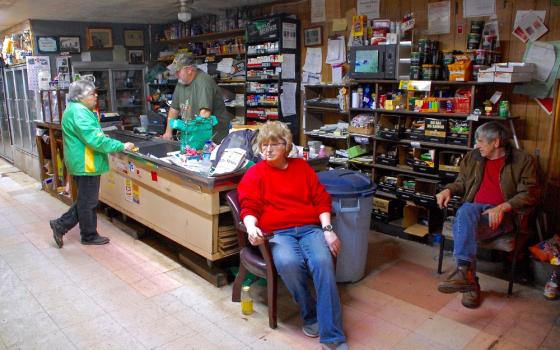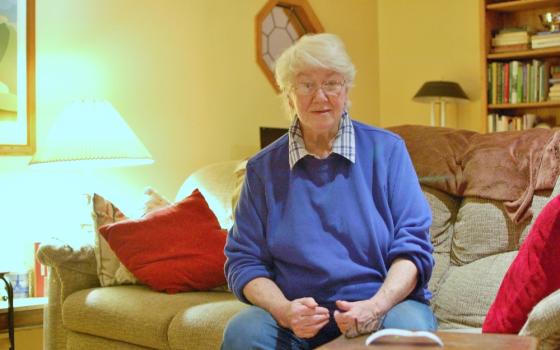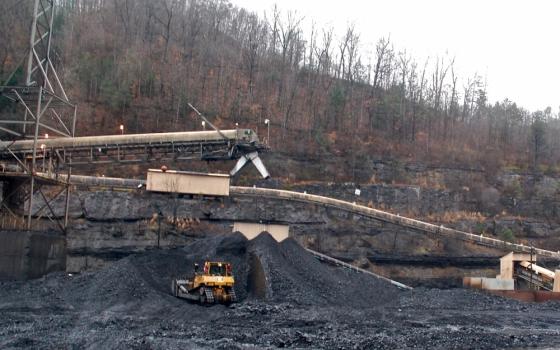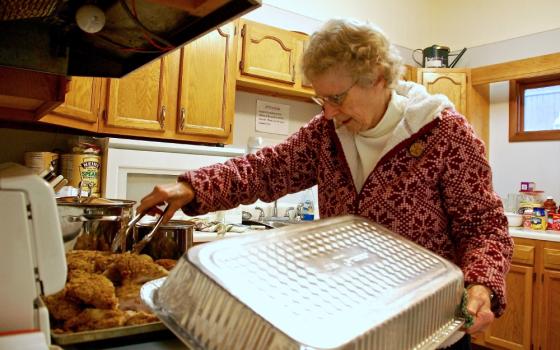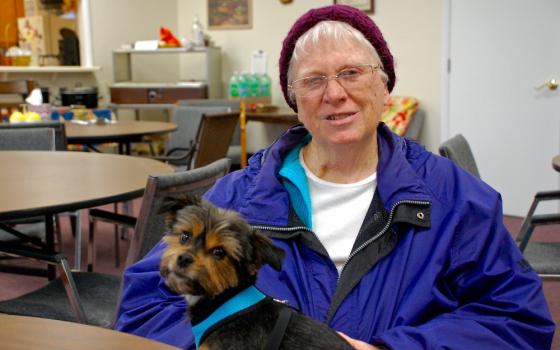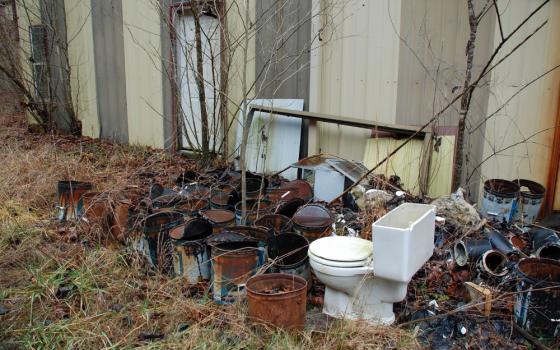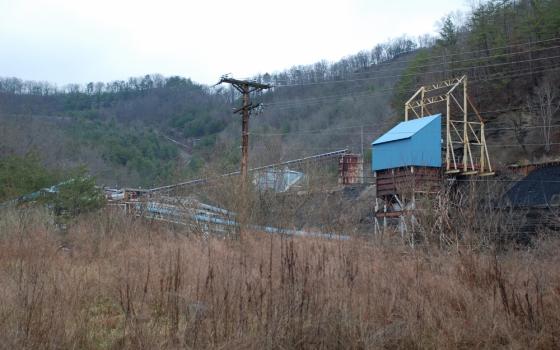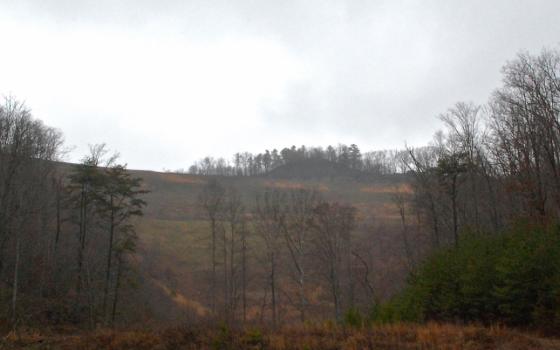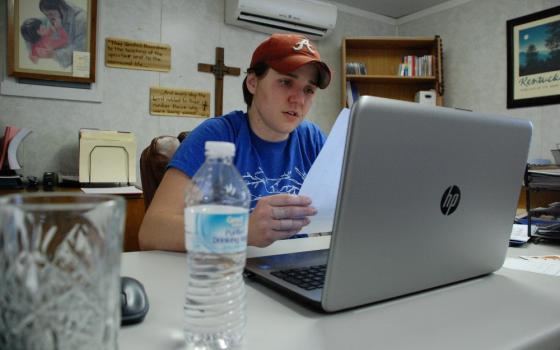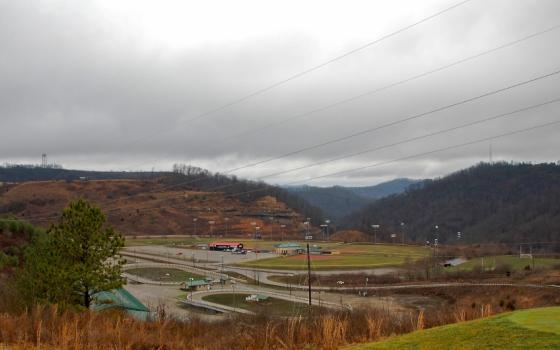Global Sisters Report presents the latest installment of our ongoing special series on mining and extractive industries and the women religious and other activists who work to limit damage and impact on people and the environment, through advocacy, action and policy.
When Notre Dame de Namur Sr. Kathleen O'Hagan and St. Joseph Sr. Gretchen Shaffer arrived in Mingo County in 1976, nearly everyone was economically poor.
Four out of every 10 people in the county lived below the federal poverty line, which was then $5,815 in annual income for a family of four. Per capita income was $4,713 — two-thirds the national average. Very few homes had electricity, and some did not have indoor plumbing. And thanks to consolidation, there was no school in the town of Kermit, where they were to serve.
"This place was so remote then, you couldn't get here with a car," Shaffer said. "The roads were like Jeep trails."
O'Hagan and Shaffer were two of numerous women religious across the United States who flocked to Appalachia after the publication of the Appalachian Catholic Bishops' 1975 pastoral letter, "This Land Is Home to Me: A Pastoral Letter on Powerlessness in Appalachia."
What the sisters found was an array of dichotomies: Unbelievable natural beauty next to gut-wrenching poverty. Enough natural resources to fuel the nation's industry for more than a century, and people unable to benefit from them much. A people who dearly love the rugged mountains they call home but are forced to destroy when the coal industry is booming — or leave to find work in the cities when it goes bust.
The sisters who came here embraced the land and its people, and many stayed despite the hardships. Though four decades have passed since the pastoral letter, the underlying problem has not changed: The people remain relatively powerless. Standards of living are higher, regulations have made coal mining cleaner, and unions have turned coal mining into safer, well-paying jobs, but the people still have little voice, leaving their fates to the whims of politics and the economy.
The conditions that keep the people they serve powerless and poor have been frustrating, O'Hagan said, but the sisters' mission is to serve them no matter what.
"Our founder [of the Sisters of Notre Dame de Namur] believed we should go and serve those that have been made poor," she said. "She said we should serve the poor in the most abandoned places."
What it's like to live here
In the 1960s, the late Edwina Pepper had pulled together parcels of land to form a land trust to preserve the ridges and hollows and to allow families who had left to find work in the cities to return home to the land they loved. Today, the conservancy Pepper created is an oasis surrounded by mining operations, created by land-holding companies that bought up huge tracts of land in order to lease the mineral rights to coal companies.
As women religious across the country responded to the 1975 pastoral letter and came to Appalachia to serve, Pepper recruited O'Hagan and Shaffer to start a school.
"We figured we'd have a week" to get the school up and running, Shaffer said. "But people wanted their kids in school today. So we basically had a day."
Big Laurel School, on top of a 400-foot ridge known as Laurel Branch, opened as a one-room schoolhouse in 1976 to serve the families living along the narrow valley carrying Marrowbone Creek to where it joins the Tug Fork River that forms part of West Virginia's western border with Kentucky.
Today, Kermit has a public school that teaches kindergarten through eighth grade. Big Laurel School closed in 1988 when the public school opened, but Shaffer and O'Hagan turned it into the Big Laurel Learning Center, where area children can learn about and appreciate the landscape around them.
The learning center also hosts church groups and college students who come to volunteer in the area, repairing homes, building wheelchair ramps, cutting firewood, and learning to love the area, as well.
Though Big Laurel has been turned into a not-for-profit with a board and an executive director, Shaffer and O'Hagan are still involved. Shaffer, 80, has mostly retired, but O'Hagan, 72, can regularly be found checking in on programs the sisters started or support, families that need assistance, and the two AmeriCorps volunteers the sisters sponsor who live in the Big Laurel Learning Center building.
On a recent day, O'Hagan's first stop is at a day care center, where she has arranged for a high school girl to do community service after what the girl thought would be a funny prank — calling in a bomb threat to school — turned out to be a federal offense.
Then it's on to Harry's Market, a tiny store that sells everything from groceries to 50-pound bags of feed corn. Owner Tony Moore's father, Harry, opened the store 75 years ago; near the lone checkout is a wood stove and two chairs filled by Tony's aunt and uncle, Arlene and Howard Moore.
Harry's is one of the last stores in the area that still lets customers buy on credit, and behind the cash register are shelves full of notebooks tracking families' tabs. O'Hagan is here to pay down a family's account so they can get groceries this week.
Then it's up the valley — or "holler," in local parlance — to a muddy road leading to an old turquoise mobile home, where litter, bike parts and a car's exhaust system are scattered in the yard. Inside, past the cats loitering outside the door hoping to get in, the carpets and floors are worn in some places to nonexistence and the coffee table holds a carton of Cheap Tobacco cigarette tubes for rolling cigarettes. The old paneled walls are covered with crosses and family photos, and the kitchen is old and small but immaculate.
The mother of the family left recently, and the grandmother and father had been having trouble keeping things together. O'Hagan has come to drop off gift cards so they can buy groceries and to see how things are going.
Today, O'Hagan discovers that the father has left, as well, but the three children and Grandma seem to have pulled together and are doing better. The middle boy has been trying to get the yard cleaned up, but there is no container to keep animals out of the trash, so O'Hagan tells the family she'll work on that problem, too.
"If I can get them the materials, they'll build it, and then they can clean up," she said. "They're doing their best in the meantime. It's actually a lot better than it was."
A changing industry
There was a time when coal miners were paid so little and preyed upon so badly by coal companies that they were little more than indentured servants, Shaffer said. That is not the case today: The Bureau of Labor Statistics reports that coal mining jobs make between $40,000 and $60,000 a year.
The problem is, those jobs are disappearing. One reason: Many power plants that used to be coal-powered have converted to natural gas — which is cheaper than coal thanks to hydraulic fracturing, or fracking — and are unlikely to invest millions to convert back.
The West Virginia Office of Miners' Health Safety and Training reported that in 2007, 1,645 people were employed in coal mining in Mingo County, producing 12.2 million tons of coal. By 2015, both of those numbers had been cut in half.
Unemployment in Mingo County was 4.8 percent when President Barack Obama took office in 2009; it peaked in February 2016 at 14.9 percent. Nearly 11,000 coal miners have been laid off in West Virginia since 2013 alone.
Mountaintop-removal mining was just coming to the region when the bishops' pastoral letter was written in 1975. Instead of dangerous underground mining, this new method used bulldozers and dump trucks, requiring fewer workers. And more than any other factor, automation has decimated the number of mining jobs: Since World War II, an estimated 100,000 coal mining jobs have been eliminated in West Virginia alone because of automation.
Mark Switzer, a retired coal miner from Morgantown, West Virginia, worked in underground mines from 1981 to May 2016. He saw firsthand how automation reduced mining jobs.
"In 1980, we had 500,000 miners. By the time I retired, we had 50,000 miners, and we were producing twice as much coal," Switzer said. "In 2000, we were mining more coal than we ever did."
Mountaintop-removal mining entails taking off the top of a mountain to reach the coal seam inside — part of the mountain is removed and dumped into the valleys between ridges, filling them to the level of the coal seam.
There is no law against taking off the top of a mountain, but there are federal environmental laws against filling in streams, and almost every valley has a stream carrying rain and snow runoff from the ridges above.
When President Barack Obama's administration started enforcing these laws in 2008, mountaintop mining was hurt badly. In December, the Department of the Interior issued a new rule to prevent coal waste from being dumped into streams. However, Republicans in Congress repealed the rule February 2, before it could take effect.
O'Hagan said in the 1970s and '80s, the stream beds were black with coal dust coming from uncovered trucks and trains. She said there's no telling what would happen if coal waste is allowed to be dumped into waterways directly.
"We've had whole communities with ruined water, and the coal companies weren't held liable," Shaffer said. "Or when they were liable, they went bankrupt."
Because coal companies and the utilities that burn coal pay two-thirds of the business taxes in West Virginia, the industry is enormously powerful: When politicians think about jobs and the economy, the sisters say, they think about coal. The result has been little diversification and a state economy deeply dependent on coal.
"Appalachia has the largest deciduous forest in the [North] Temperate Zone," Shaffer said. "Canada has the largest forest, but it's coniferous, not deciduous. They have pines, we have hardwoods. That resource is renewable. Why not harvest it in a sustainable way and give people a place to work?"
Timber could be even more valuable to the state if it had industry to use the oak, maple and walnut to make things such as furniture and cabinets, she said. But all anyone thinks about is coal.
Struggle for safety and services
Coal mining, whether underground or surface mining, is inherently dangerous. Twenty-three people have died in West Virginia mining accidents since 2012; the state reported 780 injuries in 2015 alone.
Switzer, a former union official, said union mines are safer because they require more safety inspectors. Plus, the union will not let miners work in unsafe conditions. But more and more mines are losing their unions, and safety regulations are under attack.
"We always said every safety law is written in blood," he said. "You start cutting regulations, you start cutting lives."
Injuries often lead to disability claims, said Mount Tabor Benedictine Sr. Mary Going. And these days, disability claims in Eastern Kentucky's coal country are in a sort of crisis.
Going is an attorney at the Appalachian Research and Defense Fund of Kentucky in Prestonsburg, where she helps people with family law, consumer issues, landlord-tenant disputes and domestic violence. But these days, much of her work is on disability claims, trying to help hundreds of clients — many of them coal miners who were hurt on the job — who have to retry their claims after their original attorney was charged with conspiring to defraud the government.
Going helped put together a network of volunteer attorneys from all over the country to help with the disability cases, but she said it's just another example of how people lack power.
"If you can't read well, you have a psychiatric disability, or you don't have the social support of people with those kind of skills, you're just kind of stuck," she said.
And those are on top of other barriers people face.
"There's no law out here that gives renters any rights," Going said. "There's no law saying landlords have to fix things in a certain amount of time or fix things at all. . . . There's a lack of public transportation, so even if there were jobs, there's no way to get to them. People have to pay relatives to take them places."
Nearby in David, a former coal company town, Benedictine Sr. Kathleen Weigand stops to check on things at the St. Vincent Mission, which the Brothers of Charity started nearly 50 years ago. Weigand used to be executive director here but now works part time.
Driving from Prestonsburg to David — a town so small there is no grocery store or gas station, and the Post Office is only open for 90 minutes each day — Weigand pointed out the modern highways in the area.
"Part of the reason we have good highways is because of the coal industry," Weigand said. "But most of the coal mining around here stopped about eight years ago. The mountaintop removal is just so destructive; at the same time, it's about the only industry we've got."
And the highways are where the largess has stopped. West Virginia's $2.50 tax on every ton of coal mined mostly goes to the state's general fund, though a small portion — .35 percent out of a 5 percent tax — does go to counties and towns. The Mingo County government received $11,645 for the fourth quarter of 2016. The town of Kermit, population 406, received $218.
The food pantry at St. Vincent Mission was one of the first in Floyd County, but now there are 10 because the need is so great, Weigand said. The mission is also home to a large volunteer house where church youth groups can stay when they come to the area to volunteer, helping local residents as needed.
Executive Director Erin Bottomlee said 24 groups are scheduled for this year, coming from as far away as Colorado. They will put on new roofs, repair porches, install insulation and put in windows at homes all over the area, she said.
Last year, volunteers rehabbed a house that had no heat and just wood for walls. They put in insulation, drywall and a heating system, all donated. Next year, there will be more projects that need to be done.
"Some people say [the recipients of the service projects] need to get a job, but there's no jobs around," Weigand said. "We do expect them, if they're able, to help out with the work, and they're more than willing to help out."
Mountain aftermath
In the mid-1970s, the United States was in the midst of an oil crisis, and it appeared that coal would become king again. Appalachia seemed to be on the brink of another boom cycle, especially with mining moving from underground to the mountaintops.
However, the bishops cautioned, "the new power, which a return to coal could bring to Appalachia, would probably not make its people any more powerful. Instead, they would live a different kind of powerlessness, one common to the rest of our society, the powerlessness of isolated little people in the face of the most powerful corporate giants on this earth."
Just as the pastoral letter predicted, the boom did little to change the circumstances so many in the region found themselves in. The mountaintop-removal process is much less dangerous, but it also requires far fewer miners. And it comes at the cost of the mountains Appalachians call home.
Above Prestonsburg, where there used to be 600-foot ridges and deep hollows, there is now a large, shallow saucer shape. The top 200 feet of the mountains were removed and dumped in the valleys. When the coal was gone and the mining was done, the plateau became home to StoneCrest Golf Course, surrounded by luxury homes, baseball diamonds and horse stables.
"People point to that and say, 'See what can be done with them?' " said Benedictine Sr. Eileen Schepers. "OK, well, that's one. What about the hundreds of others? And it's for the rich — not the people around here."
You'll find some of those who can't afford to live at StoneCrest at the soup kitchen at St. James Episcopal Church in Prestonsburg. That's also where you'll find Schepers and Benedictine Sr. Judy Yunker — they came to Eastern Kentucky in 1978 to found the Dwelling Place Monastery on Mount Tabor in response to a call for prayer centers to serve the religious coming to the area. Every Tuesday afternoon, 30 or 40 people come into the church soup kitchen for a free meal. The food pantry serves about 200 families a month.
Another mined-out mountain nearby is now home to a shopping center anchored by a Wal-Mart. But most are just grass-covered plateaus, marked by the gravel haul roads used by the heavy equipment that made these rough places plain.
"I love the mountains. They're so beautiful. It's like being cuddled in the arms of God," Schepers said. "That's why it's so hard to see the mines come in and tear them down. The mountaintop removal is just so devastating. You can't put it back — once it's gone, it's gone."
Because Switzer worked underground, he didn't participate in mountain destruction, but he said he understands why people take those jobs.
"I've never been in favor of mountaintop removal — there's plenty of coal you can get the conventional way without destroying the mountains and the whole ecological system around the mountains. It's just a cheaper, quicker way to get what they want," Switzer said. "Of course, my job's never been on the line because of it, either. Especially in the southern [coal] fields, it's the only game in town. It's the only source of income."
With that source of income disappearing and how easy it is to blame Obama's regulations, Republican candidates have been winning handily in recent elections. President Donald Trump promised to bring back coal jobs and won every county in West Virginia in November. He won every county but two in Kentucky.
Trump also promised to repeal the Affordable Care Act, a law many in West Virginia see as government overreach. Despite the number of West Virginians benefiting from ACA — independent insurance guide healthinsurance.org reports the ACA has cut the number of uninsured West Virginians in half — their politicians have been gunning for the program for years.
Members of the legislature have tried to invalidate the law in West Virginia, and the attorney general joined a lawsuit attempting to outlaw the subsidies that let people afford health insurance.
As a retiree, Switzer has health insurance from the coal company, but the company was sold, and the new owners say they can't afford to pay pension and insurance costs.
"I still have insurance, but it's month by month and hold your breath they don't cut it tomorrow," he said. "The little guy took the shaft again, didn't he?"
No one knows what will happen if the ACA is repealed or replaced. One thing that is likely: The provision that changed the rules surrounding Black Lung Disease, which is increasing dramatically in Appalachian coal miners, will disappear. Previously, victims had to prove their condition was caused by mining coal — a task many said was impossible. Under ACA, mining companies have to prove the disease was not caused by their workplace.
And regardless of what Trump says, the coal industry in this part of Appalachia is largely gone.
A Goldman Sachs report on the coal and gas trade said the falling demand is "irreversible." Even "the industry's most outspoken champion," Robert E. Murray, CEO of Murray Energy Corp., the nation's largest privately held coal mining company, said he does not foresee the market increasing.
"Donald Trump has the courage, the passion and the commitment to get it done," Murray told Bloomberg. "But I do not see an increase in the market for coal."
While coal executives are pinning their hopes on lower taxes and fewer regulations — Murray wants to cut the number of federal Mine Safety and Health Administration regulators in half, for example — the 11,000 miners who are unemployed in West Virginia alone are unlikely to be called back to work.
Which means the sisters in Appalachia — though their numbers are dwindling — will be more needed than ever.
And despite four decades of work, none of the sisters plans to give up on the people here.
"It's been a good 40 years," Big Laurel's O'Hagan said. "It's been hard work, but we'll continue to work until we drop."
[Dan Stockman is national correspondent for Global Sisters Report. His email address is [email protected]. Follow him on Twitter or on Facebook.]
